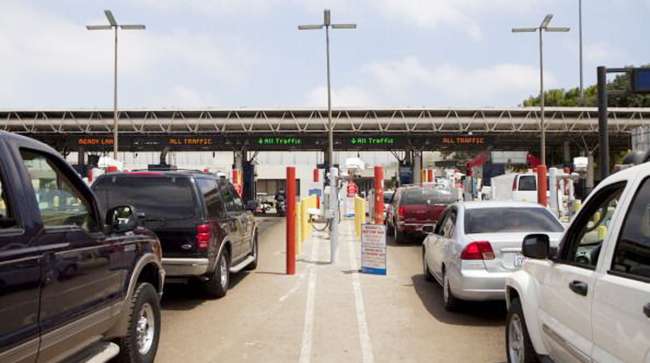Staff Reporter
GSA to Expand California’s Busiest Truck Checkpoint

[Stay on top of transportation news: Get TTNews in your inbox.]
The General Services Administration is preparing to start work on an expansion project for the Otay Mesa Land Port of Entry, California’s busiest border crossing point for commercial trucks.
The Otay Mesa crossing station is located along state Route 905 in San Diego, about 9 miles east of the San Ysidro LPOE, which is a major entry facility for personal vehicles and pedestrians. Construction on the project, which will provide infrastructure for U.S. Customs and Border Protection operations, is set to begin the first week of June.
The $137.2 million modernization effort is meant to expand processing capacity for trucks and pedestrians moving between San Diego and Tijuana, Mexico. Specifically, the project will include an expanded northbound commercial truck inspection facility that will increase the number of inspection booths from 10 to 16, as well as a modernized pedestrian inspection facility that will double processing capacity from six lanes to 12.

Otay Mesa Port of Entry. (gsa.gov)
One goal of the project is to improve circulation for trucks moving through the facility. Anthony Kleppe, Region 9 Land Port of Entry program manager for GSA, explained that, under the current layout, trucks approaching the Otay Mesa LPOE have to make a sharp turn to exit the facility after they’ve been cleared by CBP.
GSA’s Region 9, known as the Pacific Rim Region, spans from Window Rock, Ariz., to Seoul, South Korea.
“Probably the single greatest problem with commercial logistics within the existing Otay Mesa Port of Entry is issues of circulation,” Kleppe told Transport Topics. “During peak hours, it gets pretty congested within the port itself. A big part of the project is about increasing the area for circulation and amending the alignment for traffic.”
Additionally, the project will involve the construction of a commercial annex building, which will house the Secure Electronic Network for Travelers Rapid Inspection (SENTRI) enrollment center, a parking structure for employees and a bus inspection facility, as well as the development of a plant inspection station. That station will house the Department of Agriculture’s Animal and Plant Health Inspection Service personnel, whose duties include ensuring imported agricultural products meet the agency’s requirements to exclude pests and diseases.
The $741M San Ysidro Land Port of Entry expansion was a major win for the SD-TJ megaregion. Now @USGSA is kicking off efforts to expand the Otay Mesa Port!
$137M project
Est. completion: Spring 2023
Double pedestrian lanes, 6 new import booths and morehttps://t.co/GC1p0MQ02M pic.twitter.com/sywQiNXsCD — Kevin Faulconer (@Kevin_Faulconer) May 26, 2020
The Otay Mesa LPOE is an important crossing point. The facility cleared 948,630 trucks in 2019, according to the Bureau of Transportation Statistics. This figure exceeds the volumes seen at California’s other border facilities that process trucks. BTS data indicates that, in 2019, the Calexico East LPOE cleared 389,046 trucks and the Tecate LPOE cleared 65,212.
According to GSA, the Otay Mesa LPOE processed $18 billion in exports and $34 billion in imports during fiscal 2019. Kleppe noted that Tijuana, the Mexican state that lies opposite the border from Otay Mesa, maintains large industries for electronics and medical devices.
“It’s the largest commercial port of entry in the state of California,” Kleppe said. “It is an important facility. Otay Mesa is an invaluable part of the economy in San Diego, as well as the U.S. as a whole.”
As work progresses, Kleppe said the project will be compliant with local guidelines to protect employees, construction workers and the traveling public from COVID-19. Completion is estimated for the spring of 2023.

How can trucking companies adjust to ensure that essential freight keeps moving while protecting their workers from coronavirus? Host Seth Clevenger speaks with Lilli Chiu of Hub International and Dave Cox of Polaris Transportation. Hear a snippet, above, and get the full program by going to RoadSigns.TTNews.com.
In December, GSA completed a 10-year construction project at the bustling San Ysidro LPOE near Otay Mesa. Completed in three phases, the San Ysidro project involved reconstructing inspection areas, administration buildings and pedestrian facilities.
“San Diego’s ports of entry are among the busiest in the world, with millions of people and billions of dollars in commerce crossing the border every year,” San Diego Mayor Kevin Faulconer said. “We welcome the federal government’s investment in our border infrastructure, as we’ve seen firsthand the positive impact of the recently completed expansion of the San Ysidro Land Port of Entry. Now we’re looking to grow this economic engine even more by increasing processing capacity at the Otay Mesa Port of Entry.”
Want more news? Listen to today's daily briefing:




